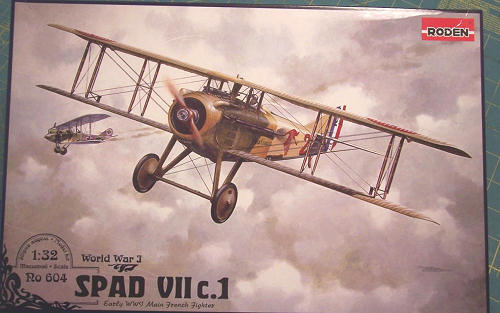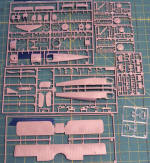
| KIT #: | 604 |
| PRICE: | $69.99 MSRP Save $20 at Earls Hobby Hanger |
| DECALS: | Three options |
| REVIEWER: | Kyle Bodily |
| NOTES: |

| HISTORY |
SPADs were a lot like Messerschmitts,
Mustangs and Spitfires.
It was the aeronautical definition and
representative for its country of origin during its service time.
It would go on to become one of the aircraft that
defined the air war.
It was not accepted outright by airmen who had
become accustomed to effortlessly throwing their aircraft around the sky.
When it first entered combat the Hispano-Suiza
engines that were installed were only 150 hp.
This gave it performance similar to German aircraft
at the time.
Like most new weapons systems that
require the operator to learn new techniques and tactics, It took a little time
for the line pilots to learn what an advantage they had been given.
After effortlessly zipping around the sky in their
Nieuport 17s, French pilots considered the SPADs flight characteristics to be
“that of an asthmatic truck”. It had no dihedral and no wing stagger.
This resulted in “an almost negative inherent
stability”.
The SPAD required a very high landing speed that was made
for difficult landings on wartime airfields.
In flight maneuvers the SPAD was considered nowhere
near as maneuverable as the Nieuport. Arch Whitehouse wrote, “it was foolish to
duel for any length of time with Fokker, Albatros and Pfalz single-seaters.
The routine was to attack from advantageous levels
and if the pass did not come off, it was wise to remember the rugged
construction of the SPAD and keep on diving.”
It was not long before the SPAD drivers found that the new fighter was a very good fighter. If they refused to fight the Germans on the Germans terms and only fight them on their own terms.
The famous Ace George Guynemer fell in love with it right away and later wrote “She loops wonderfully, Her spin is a bit lazy and irregular, but deliciously soft.”
The big advantages of a SPAD driver was the ability to out run, out climb and out dive the enemy. With these advantages you had the ability to engage or break off combat at will and thus the French pilots could fight the battle that they wanted.
| THE KIT |
 The
first thing that I noticed when I opened the box was that this kit seemed to
have more parts than any of Roden's earlier 1/32 scale kits.
The plastic is the same gray/beige as earlier
offerings.
The suture marks are still present on the larger parts but
don’t seem to leave any visible marks on the surface of the parts.
One thing that Roden got right here is that they put
the ejector pins in places that will be hard to see once the model is assembled.
I would say the kit is about 99% flash free.
The plastic is also very heavy, soft and flexible.
If you have worked with any low pressure, limited
run kits then I think you’ll be familiar with this type of plastic.
A problem with this kind of soft plastic is that it
is prone to sink holes, but at first look I see only two slight ones at the
propeller hub.
They will be fixed with some putty.
The
first thing that I noticed when I opened the box was that this kit seemed to
have more parts than any of Roden's earlier 1/32 scale kits.
The plastic is the same gray/beige as earlier
offerings.
The suture marks are still present on the larger parts but
don’t seem to leave any visible marks on the surface of the parts.
One thing that Roden got right here is that they put
the ejector pins in places that will be hard to see once the model is assembled.
I would say the kit is about 99% flash free.
The plastic is also very heavy, soft and flexible.
If you have worked with any low pressure, limited
run kits then I think you’ll be familiar with this type of plastic.
A problem with this kind of soft plastic is that it
is prone to sink holes, but at first look I see only two slight ones at the
propeller hub.
They will be fixed with some putty.
The majority of all the little bits seem to be mostly marked for the engine and cockpit area. Sadly I don’t think that you will be able to see most of these parts once the model is built. But it is nice to know that they are in there, even if you are the only one that knows.
All the surface areas have the classic pebbly finish that is very reminiscent of the DML SPAD 13 kits of the 1990s. I think that a coat of paint will cover that up.
The sprues were molded with a lot of
parts to build the early and final production versions. All the parts that are
not needed in this kit have been past Betty Bendemoff so you will not get any
unneeded parts to rattle around your spares box.
I’ve been told that plastic is like gold in
Oh, I forgot to tell you, the kit includes only parts for a late enlarged cowling version. The only problem here is that the radiator is exposed and it has ABSALUTLY NO DETAIL on it. I’m not kidding here, it is just a Hexagonal slab with a central bump for the propeller shaft. I guess that you can fix this with a piece of fine screen.
 The
instructions are classic Roden.
Clear, large and printed on eight pages.
I can’t think of any more to say here, but that I
wish more companies did as nice a job.
The
instructions are classic Roden.
Clear, large and printed on eight pages.
I can’t think of any more to say here, but that I
wish more companies did as nice a job.
Last but not least the decals. Like all Roden decals they look to be printed spot on. I look forward to trying them out. I want to see if they are any better then earlier experiences. In the past I’ve found that the white in Roden decals is not opaque and that they don’t respond to Solvaset at all. The colors look a bit off to me. The French national colors are represented as an orange red and very bright blue. Who knows, maybe after I apply them to the model they’ll look better.
| CONCLUSIONS |
I think that any of the problems
that might be encountered will be easily conquered with a little patience
especially since Roden kits are known for there fiddly nature.
If I were to pick one thing about this
kit that I would like to change it would be the French national colors on the
decals.
The more I look at them the more they jump out at me as
being wrong.
I compared them to other decals of the French cockade and
they really look more orange then red and the blue looks strikingly bright.
Oh well I guess I can’t have everything.
| REFERENCES |
“French Aircraft of the First World War” by Dr. James Davilla and Arthur M. Soltan, Flying Machines Press (This is arguably the best publication on French aircraft used or designed during the First World War and well worth the price).
“SPAD Fighters in Action #93” Squadron/Signal Publications
“SPAD 7c1” Windsock Datafile #8
Review kit was courtesy of Earls Hobby Hanger in Logan, Utah.
November 2008